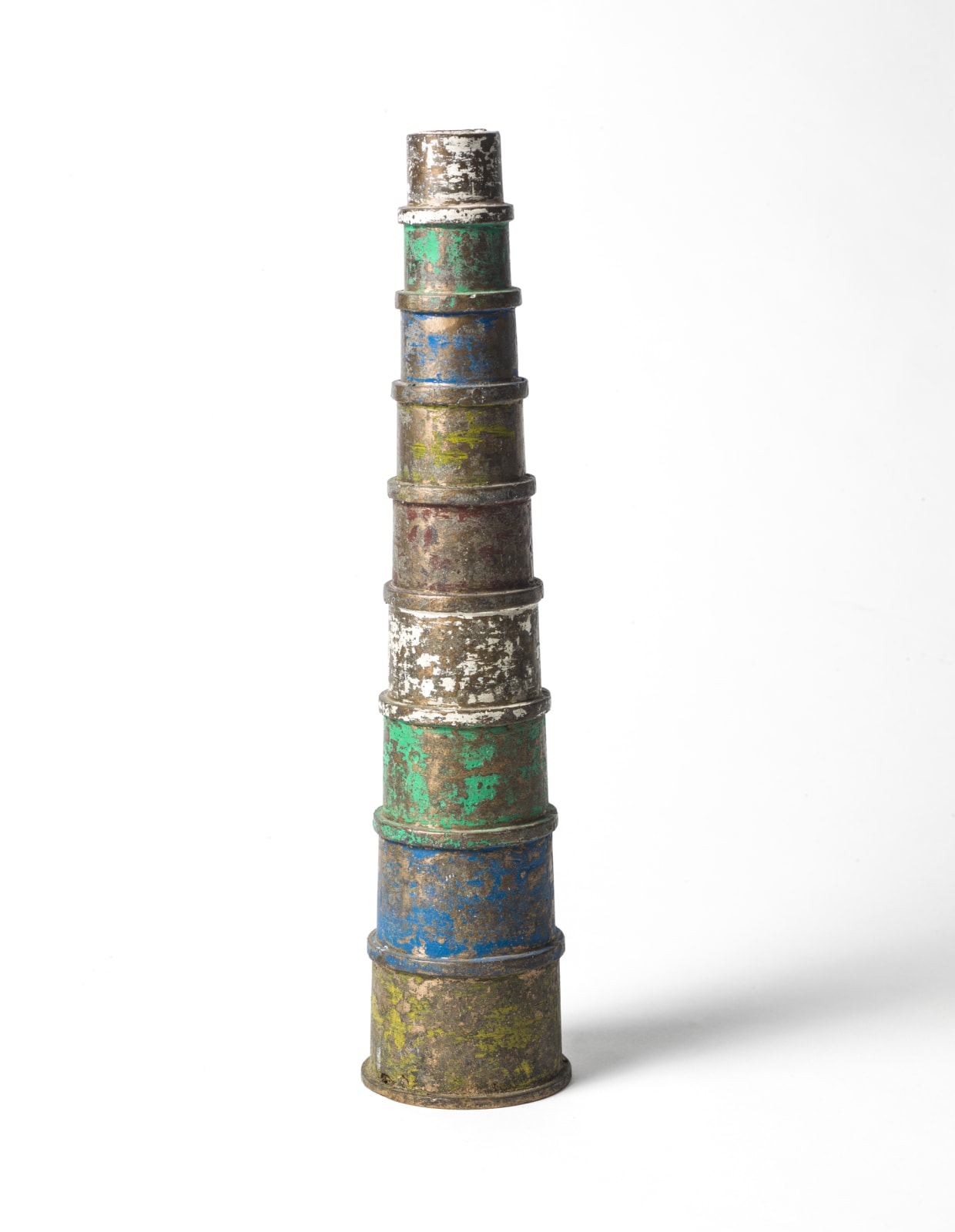Carl Plackman British, 1943-2004
Small Stacking Cups, 1982/3
Hand-painted bronze
37 x 8 x 8 cm
14 5/8 x 3 1/8 x 3 1/8 in
14 5/8 x 3 1/8 x 3 1/8 in
Unique
Further images
'Stacking Cups', 1982 is an exceptionally rare and unusually small work by Carl Plackman cast in bronze. It offers a glimpse of the humour that is often overlooked in Plackman's...
'Stacking Cups', 1982 is an exceptionally rare and unusually small work by Carl Plackman cast in bronze. It offers a glimpse of the humour that is often overlooked in Plackman's work as he is considered one of the most challenging sculptors of his day. A generous and influential teacher, he developed his work whilst lecturing at Goldsmiths College, London and other institutions across the UK. Many of the students he taught have since become major names in British contemporary art including Tony Cragg, Damien Hirst, Liam Gillick and Alison Wilding.
Talking about his conversations with Plackman during his time at Goldsmith’s Hirst remembers: “It didn’t really answer any of the complex questions the work raises [Plackman’s], as invariably an insight into the man doesn’t necessarily shed light on the work of an artist. In fact if anything it made the work more enigmatic, more mysterious. But what it did give me was a belief in the work, a belief that there was a sound logic reverberating around the mini-universes he created, a logic that could be trusted, a logic where seemingly a playful god reigned supreme unencumbered by trivialities and rules such as clear narrative, reason and gravity, rules that are mostly helpful but, as we often forget, can sometimes hold us down too firmly.”
Carl Plackman studied at the Royal College of Art under the tutelage of Bryan Kneale, Bernard Meadows and Ralph Brown. His work consists of sculpture, drawings, installation and occasionally photographs. In many cases his work is an attempt to examine how people communicate with each other and how objects often get in the way. The work appears to use real objects but more often than not these have been completely remade in a different material that become a decoy or a sham. The work often grew out of his interest in poetry, philosophy, cinema and the origins of language but he also became concerned with the subversiveness of the silent still image. His work can be found in a number of prestigious permanent collections including the Tate Collection, Arts Council Collection, The Henry Moore Institute, Victoria and Albert Museum, British Museum, National Museum of Wales and the Art Gallery of New South Wales, Australia.
Talking about his conversations with Plackman during his time at Goldsmith’s Hirst remembers: “It didn’t really answer any of the complex questions the work raises [Plackman’s], as invariably an insight into the man doesn’t necessarily shed light on the work of an artist. In fact if anything it made the work more enigmatic, more mysterious. But what it did give me was a belief in the work, a belief that there was a sound logic reverberating around the mini-universes he created, a logic that could be trusted, a logic where seemingly a playful god reigned supreme unencumbered by trivialities and rules such as clear narrative, reason and gravity, rules that are mostly helpful but, as we often forget, can sometimes hold us down too firmly.”
Carl Plackman studied at the Royal College of Art under the tutelage of Bryan Kneale, Bernard Meadows and Ralph Brown. His work consists of sculpture, drawings, installation and occasionally photographs. In many cases his work is an attempt to examine how people communicate with each other and how objects often get in the way. The work appears to use real objects but more often than not these have been completely remade in a different material that become a decoy or a sham. The work often grew out of his interest in poetry, philosophy, cinema and the origins of language but he also became concerned with the subversiveness of the silent still image. His work can be found in a number of prestigious permanent collections including the Tate Collection, Arts Council Collection, The Henry Moore Institute, Victoria and Albert Museum, British Museum, National Museum of Wales and the Art Gallery of New South Wales, Australia.
Provenance
From the artist's estateExhibitions
Carl Plackman and his Circle, 2019, Pangolin LondonMasterpiece Art fair, London 2019.
Join our mailing list
* denotes required fields
We will process the personal data you have supplied in accordance with our privacy policy (available on request). You can unsubscribe or change your preferences at any time by clicking the link in our emails.







